
In 1971 Enzo Ferrari and long-time stylist Sergio Pininfarina revealed the 365 GT4/BB at the Turin Auto Show. The car was the hit of the event. With some lateral thought and brilliant development, Ferrari ushered in a new paradigm at the top of its product range. Even before the first production model hit the streets in 1973, the BB – for Berlinetta Boxer – became the supercar of its era, an icon of the carefree 1970s that remains vastly desirable in the 21st Century. Enhancing North American interest was Ferrari’s uncompromising view of the relationship between US and Canadian government regulations and the purity of his sports cars: the former would not dictate the latter. As a result, the 365 GT4/BB and its successors, the 512 BB and 512 BBi, were never officially imported or sold in North America. Nonetheless, enthusiasts could not be kept away from the car and a good many were brought over, legalised, and continue to thrill drivers today
The heart of Ferrari’s top models has always been a V12 engine. The new car was powered by a 4.4 liter 180-degree V12, which made 360bhp at 7500rpm. In 1976 the 512 BB was released with a 4.9 liter Flat-12 making 340bhp, a slight reduction in power which was more than offset by a 10% increase in torque. In 1981 the engine, threatened with strangulation by European emissions rules, was given fuel injection and retained a power rating of 340bhp, and another slight increase in torque. The sensuous Pininfarina design and the powerful Ferrari engine are the things which superficially define the Boxer. The car is really set apart, however, by its surprising degree of comfort. The 365 GT4/BB was designed as a Gran Turismo, a high performance touring car. For this reason, the cabin was made spacious, the windows made large, the rearward vision excellent, and the suspension compliant
The Boxer offered much to lure the cognoscenti: a mid-rear, Flat-12 engine based on contemporary F1 technology, a luxurious and amazingly spacious interior, a ride of sublime comfort, and one of the sexiest bodies over to clothe four wheels. And it remains very, very fast
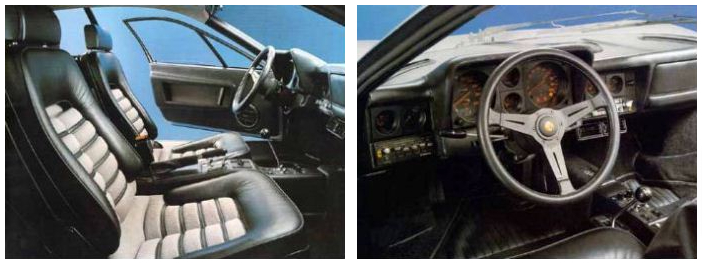

The body of the Boxer was designed for strength and efficiency, its extreme beauty following from these traits. The body of a car should not simply cover the chassis and cabin, it should interact with them to form a whole. With luck, the design makes a bold and striking statement. In all of these areas, the Boxer was supremely successful. The car was long, low, and sleek. This impression was accentuated on production cars by use of the ‘Boxer colour scheme’ featuring matte black below the beltline. The nose curved up from the ground in contemporary sports-racing car style. Great emphasis was placed on passenger comfort, the cabin and door openings were as large as practically possible, and a large ‘greenhouse’ offers excellent outward vision and light, particularly given the buttresses extending over the rear wheels to enclose the deck.
Pininfarina was just beginning serious application of aerodynamics to road car design when the Boxer was styled as Ferrari’s first road car to ensure rather than suggest performance. The curves of the body hugged the chassis beneath. The look was aggressive, with large flares over the rear wheels, a purposeful visage to the front and rear, and a bobbed tail. The 365 GT4/BB had no visible holes to mar its lines; air entered the carburettors through ducts in the rear engine cover. When the 512 BB gained NACA ducts to cool the rear brakes, they were almost invisible and pleasingly sporting. The combination of sensuous curves and aggressive details correctly suggest the iron fist in a velvet glove.
The shape was uncontroversial in its beauty. The design was a departure only in its simplicity of mated form and function, something not previously associated with mid-engined road cars. The Boxer of 1984 is readily identifiable as a slight evolution of the car it was in 1973. Small styling differences between the 1973-76 365 GT4/BB, the 1976-81 512 BB, and the 1981-84 512 BBi are visible primarily in details such as revised front driving and indicator light fairings, a changed lower front valance and spoiler, reduction of tailights and exhaust tips from the six of the 365 GT4/BB to the four of later models, and small NACA ducts feeding air to the rear brakes behind slightly wider rear wheels.
In normal Ferrari practice, the Boxer’s chassis is primarily formed from steel tubes. Unusually, the tubes were a mixture of round- and square-section, depending on the needs of the chassis at a given point. The cabin formed a semi-monocoque with tube sub-frames at the front and rear to mount the drivetrain and suspension. The floor and other stress-bearing interior panels were made of aluminum or galvanized steel sandwiched within fibreglass; a virtually non-corrodable combination. The body was likewise formed from galvanized steel, fibreglass, and alloys where appropriate. Pininfarina was daring in the use of a rear-hinged rear deck. Access to the engine and drivetrain was aided by the fact that the entire rear body of the car opened, while the car’s bonnet lid, which comprised much of the fore-section, lifted forward in clamshell fashion. The Boxer was a rigid, strong car offering a combination of superb handling and secure comfort. One advantage of a ‘boxer’ engine was that it can be mounted very low in a chassis. The unusual design of the transmission, beneath the engine, raised the centre of gravity but allowed for both a smaller car and a spacious cabin. The combination engine-transmission was a singularly compact mass that could be exactly placed within its chassis. Weight distribution is a nearly ideal and easily controlled 43-57, with the bias to the rear. The 512 BB and BBi have a slightly different front-rear weight distribution of 40-60. The otherwise unaltered suspension was retuned to balance this change.
365 GT4/BB
Chosen for its compactness and natural harmony, the ‘Flat’ 12-cylinder engine, often referred to as a ‘boxer’ for the way its horizontally-opoosed pistons mimic the actions of sparring pugilists, is a marvel of efficient design. The 365 GT4/BB appeared in 1973 with a 4390cc block cast in silumin, an aluminum alloy. The bore was 81mm and the stroke 71mm. The four overhead camshafts were driven by toothed belts rather than chains. The camshafts actuated two valves per cylinder. At the centre of the engine lies a seven main bearing crankshaft milled with the unsurpassed precision necessary to a boxer engine. A very safe compression ratio of 8.8:1 was engineered. This combination gave 360bhp at 7500rpm, and 311lb-ft of torque at 4500rpm. The 365 GT4 had Weber carburettors fed by twin pumps from a 46 gallon reservoir. Ignition was Marelli Dinoflex and lubrication was via wet sump. Aided by fans, a single front-mounted radiator provided cooling. View the 365 GT4/BB
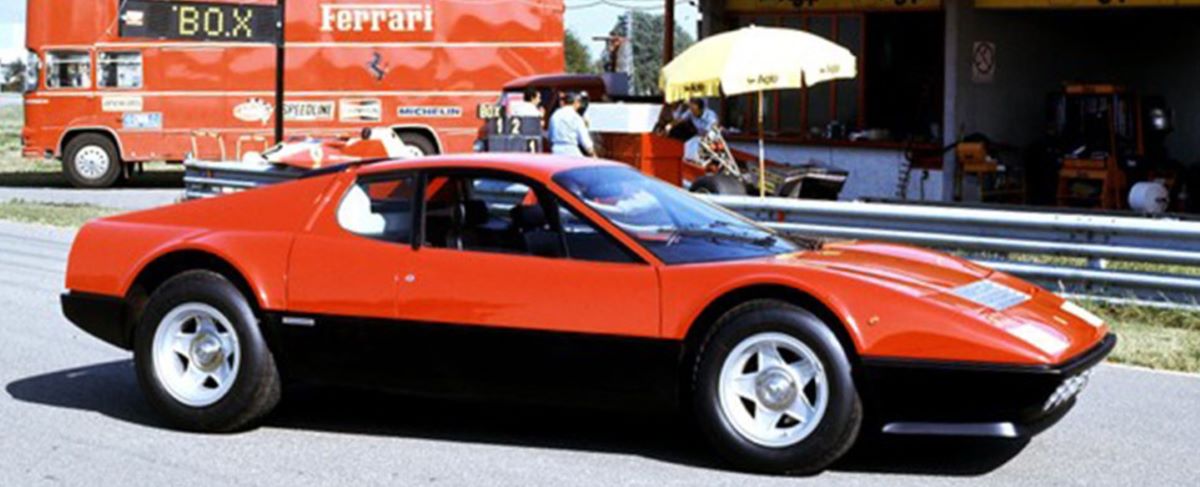
512 BB
The powerplant of the 1976-81 512 BB was enlarged to 4942cc by increasing the bore to 82mm and the stroke to 78mm, and raising compression to 9.2:1. With squarer cylinders the new engine achieved a conservative 340bhp and 331lb-ft at lower engine speeds than its predecessor. Dry sump lubrication was also installed.
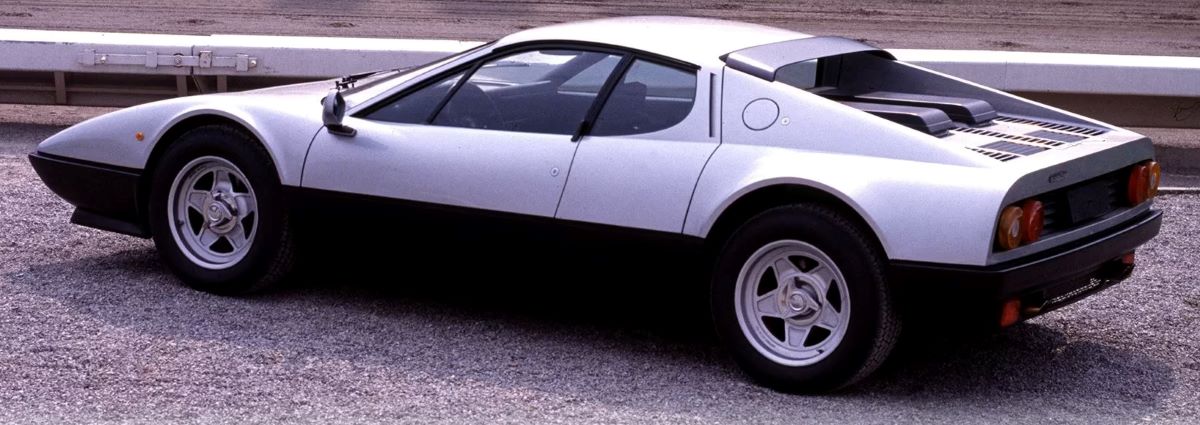
512 BBi
In its final revision, the 512 BBi’s engine saw a Bosch K-Jetronic fuel injection system replacing carburretion, making it more tractable and fuel efficient in a greater variety of conditions. The 512 BBi has 340bhp at 6000rpm and 333lb-ft at 4600rpm.
Bosch K-Jetronic mechanical fuel injection on the 512 BBi replaced the outgoing model’s four, triple-choke Weber 40 IF 3C carburettors. Otherwise mechanically identical, the flat-12 featured lower maximum revs (6,600 rpm compared to the 512 BB’s 6,800 rpm) and the engine developed 20 bhp less, although top speed remained within a whisker of the 512 BB’s 283 km/h.
Externally the new model was recognisable by the re-designed rear bumper and wheels, the side NACA duct finished in black and the body-colour wing mirror. Inside, the classic Connolly leather seats featured a central wool textile insert and the car was fitted with air conditioning and central locking as standard.
The 512 BBi was introduced at the 1981 Frankfurt Salon, to replace the 512 BB model, the “i” suffix denoting a change from carburettors to fuel injection. Apart from the adoption of fuel injection, in line with the other models in the Ferrari range at the time, there were minor cosmetic and mechanical changes. At the front the plain aluminium egg-crate radiator grille stopped short of the driving lights, which were now exposed in the grille extremities, with small rectangular parking lights mounted in the bumper section above them. At the rear the engine louvre arrangement was modified and a new shroud was provided to the exhaust system, which incorporated hazard warning lights. A new design of door mirror was fitted, changes were made to the interior, including a black spoked steering wheel, and the availability of “Zegna” wool cloth seat centres as an option. The road wheels became the same width front and rear, fitted with Michelin TRX tyres, which had the effect of increasing the front and rear track to 1508mm and 1572mm respectively.
The body was mounted on a 2500mm wheelbase chassis, which had factory reference number F 102 CB 100. All were numbered in the odd chassis number road car sequence, and the construction followed the same principles as its predecessor of a tubular steel chassis frame with a monocoque central cell. Again as with its predecessor it was available in right or left hand drive form, and again no USA market versions were built. The standard road wheels were alloy five spoke “star” pattern, with a knock off spinner on a Rudge hub, although legislative requirements in some markets dictated the fitment of a large octagonal hub nut. The wheels covered large ventilated disc brakes with twin hydraulic circuits, and servo assistance. Independent suspension was provided all round, via wishbones, coil springs, and hydraulic shock absorbers, with twin rear units, together with front and rear anti roll bars.
The aluminium flat twelve cylinder engine was of the same configuration as its predecessor with a cubic capacity of 4943cc, and 82mm x 78mm bore and stroke, with factory type reference F 110 A 000. It featured belt driven twin overhead camshafts per bank, with dry sump lubrication and a hydraulically operated clutch. The 512 BBi was fitted with Bosch K-Jetronic fuel injection, and had the same claimed power output as the carburettor model. The production period ran from 1981 to 1984, when it was replaced by the world market Testarossa model. During that period a total of 1007 examples were produced, in the chassis number range 38121 to 52935.
Transmission
As part of the effort to perfect a midship Flat-12 design on the first attempt, Ferrari placed the five-speed transmission directly below and slightly offset to the rear of the longitudinally aligned engine. Drive is transferred from the engine via strong chains, and through a single-plate hydraulic clutch in the 365 GT4/BB, and a dual-plate hydraulic clutch in the 512 BB and 512 BBi.
The all-syncromesh transmission consists of five forward and one reverse close ratio gears, fourth being an underdrive and fifth an overdrive. The 512 BB and 512 BBi have slightly shorter gearing than the 365 GT4/BB, which helps account for their lower top speed and more consistent acceleration.
The limited-slip differential employs a helical spur gear crown wheel and pinion. The 512 BB/i have a slightly taller final drive than the 365 GT4/BB.
As a Gran Turismo, the Boxer was never geared for ultimate velocity, although it could exceed 170mph without modification. Rather, the transmission of the Boxer was designed for enjoyable interaction between human and machine. It provides for extremely spirited acceleration, and safe passing in any gear, with more than enough speed for the race track or the road.
A by-product of Ferrari’s desire to perfect its first attempt at a Flat-12 mid-engined road car was a firm intention that the car would hold the road within the limits of the average driver. For this reason the chassis was provided with a superb and perhaps overbuilt suspension. Under no circumstances was an average driver to be taken by surprise with a sudden, rapid oversteer. For all its power, the Boxer was a benign handler
On each side, the front suspension was the classic Ferrari design built from a coil spring over a shock absorber located by dual A-arms of unequal-length. At the rear, the dual unequal-length A-arms located twin coil springs over twin shock absorbers by Koni or Miletto, one fore and one aft of the driveshaft’s center line. This unusual arrangement functioned so well in keeping the Boxer in optimum contact with the road surface that it was modified for use in a variety of subsequent Ferraris. To further enhance the stability, tuneability, and cornering power of the suspension, anti-rollbars are attached at the front and rear. Aside from minor retuning for the 512 BB and 512 BBi, the suspension was identical on all Boxers.
The Boxer was stopped by vented disc brakes at all four wheels. The brakes were power-assisted, with a dual fail-safe system to ensure complete and even operation at all times. Stopping power was provided by 11.3″ front rotors and 11.6″ rear rotors.
As befits Ferrari’s most prestigious car, the steering was extremely accurate, thanks to an unassisted rack and pinion system.
The Boxer was amongst the first cars to wear Ferrari’s now standard five-spoke alloy wheels. Each one-piece casting was fixed to its hub by five bolts. The 365 GT4/BB carried Cromodora 15″X7″L wheels with Michelin XWX 215VR70 tires. Reflecting the change in weight distribution, the 512 BB and 512 BBi were given larger wheels and tires at the rear. These later models carried Cromodora 15″X7.5″L wheels at the front, with 215VR70 XWX tires. At the rear were Cromodora 15″X9″Ls with 225VR70 XWXs. Optionally, some 512 BBis were sold with Michelin TRX 240VR55 tires, necessitating special wheels of metric size.
The sensuous Pininfarina design and the powerful Ferrari engine were the things which superficially defined the Boxer. The car was really set apart, however, by its surprising degree of comfort. The 365 GT4/BB was designed as a Gran Turismo so the cabin was made spacious, the windows made large, the rearward vision excellent, and the suspension compliant. The Boxer’s interior changed little over the model’s life. Production 365 GT4/BB had rounded, highly supportive, thin-shelled seats of pleated leather, designed to breathe. The interior matched the seats, with simplicity being the watchword. The steep rake of the windscreen dictated a deep dashboard, surmounted by ventilation nozzles. The instrument binacle was square and contained small oil pressure and coolant temperature guages with a large 320Km/H speedometer and an equally large 10,000rpm tachometer. Smaller binacles hung on either side of the main one, angled towards the driver. All guages were orange on black, easily seen behind the traditional three-spoke Momo wheel. Without a transmission intruding on the cabin, the console between the seats was slim and low. At the driver’s right, surmounted by a polished gate, protruded the long and slender gear shifter with spherical grip. Behind the seats were modest leather-lined storage racks. The 512 BB and 512 BBi interiors were essentially unchanged from that of the 365 GT4/BB
Specifications and Features
Production from 1973–1984 with a total of 2,323 produced
- BB 512: 1976–1981 (929 produced)
- BB 512i: 1981–1984 (1007 produced)
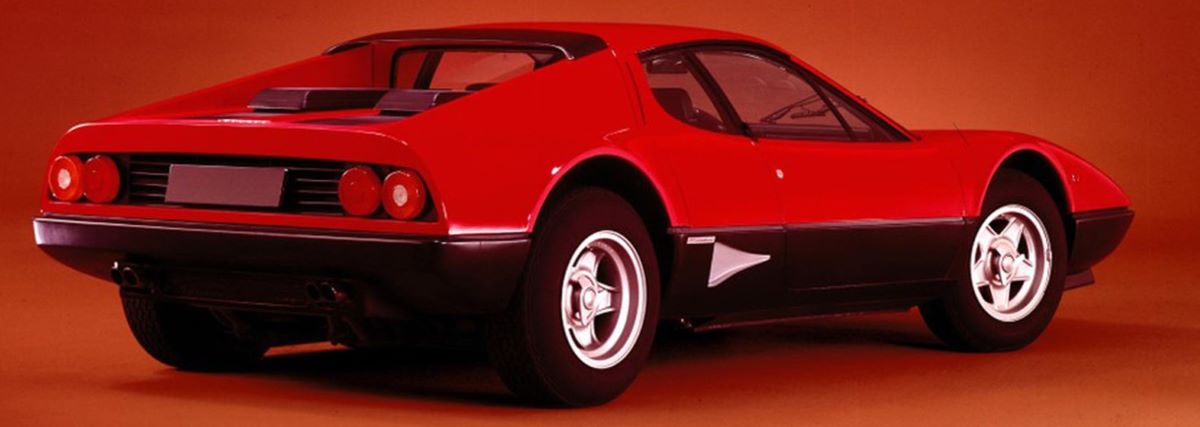
512 BB
|
Dimensions |
|
|
Length |
173.3 in |
|
Width |
72.0 in |
|
Height |
44.1 in |
|
Wheelbase |
98.4 in |
|
Front track |
59.1 in |
|
Rear track |
61.5 in |
|
Weight (Dry) |
3084 lbs |
|
Wheels front |
7.5L x 15 |
|
Wheels rear |
9L x 15 |
|
Tires front |
215/70 VR 15 |
|
Tires rear |
225/70 VR 15 |
|
Engine |
|
|
180° alloy V12 mounted longitudinally rear amidship / Dual Overhead Camshafts, Two valves per cylinder |
|
|
Displacement |
4942cc |
|
Bore & Stroke |
82mm x 78mm |
|
Compression |
9.2:1 |
|
Fuel Delivery |
Carburettors |
|
Fuel System |
4 x 3 choke Weber 40IF3C |
|
Ignition |
Marelli Dinoflex AEC 104BK |
|
Maximum Power |
340bhp @ 6800 rpm |
|
Maximum Torque |
331lb-ft @ 4300 rpm |
|
Specific Output |
69 bhp / liter |

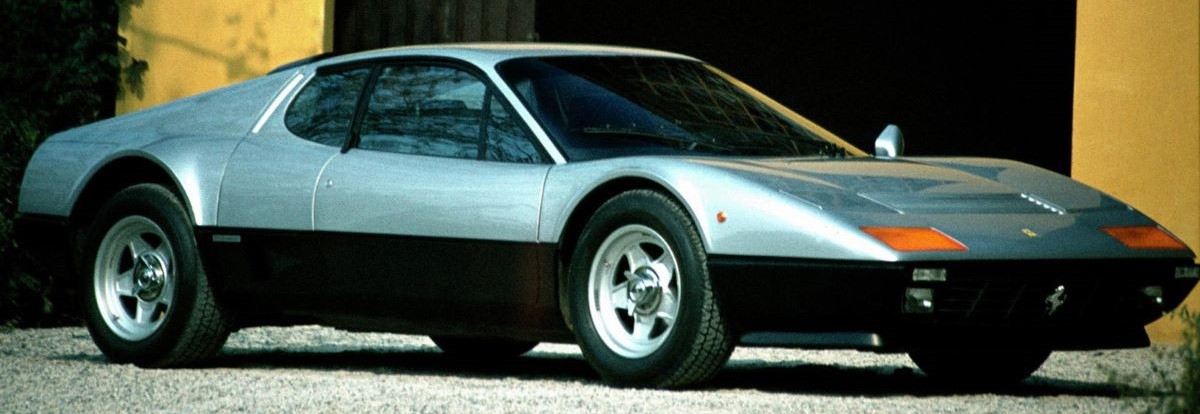
512 BBi
|
Dimensions |
|
|
Length |
174.0 in |
|
Width |
72.0 in |
|
Height |
44.7 in |
|
Wheelbase |
98.4 in |
|
Front track |
59.1 in |
|
Rear track |
61.5 in |
|
Weight (Dry) |
3800 lbs |
|
Wheels front |
7.5L x 15 |
|
Wheels rear |
9L x 15 |
|
Tires front |
215/70 VR 15 |
|
Tires rear |
225/70 VR 15 |
|
Engine |
|
|
180° alloy V12 mounted longitudinally rear amidship / Dual Overhead Camshafts, Two valves per cylinder |
|
|
Displacement |
4942cc |
|
Bore & Stroke |
82mm x 78mm |
|
Compression |
9.2:1 |
|
Fuel Delivery |
Fuel Injection |
|
Fuel System |
Bosch K-Jetronic |
|
Ignition |
Bosch K-Jetronic |
|
Maximum Power |
340bhp @ 6000 rpm |
|
Maximum Torque |
333lb-ft @ 4600 rpm |
|
Specific Output |
69 bhp / liter |

You must be logged in to post a comment.